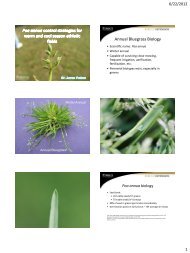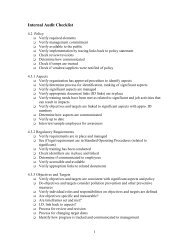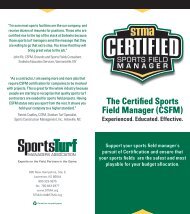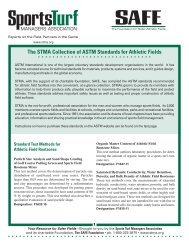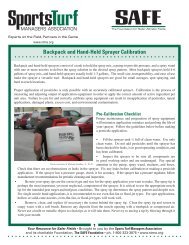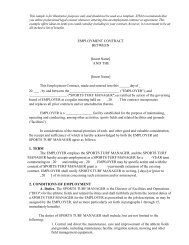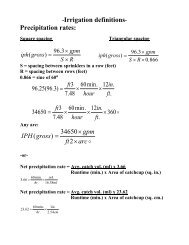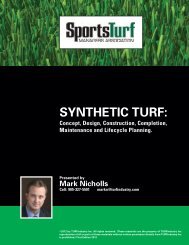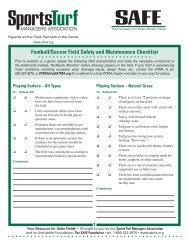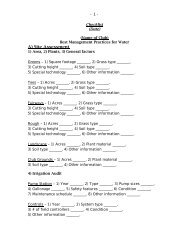Winter Athletic Field Maintenance Calendar for the ... - STMA
Winter Athletic Field Maintenance Calendar for the ... - STMA
Winter Athletic Field Maintenance Calendar for the ... - STMA
Create successful ePaper yourself
Turn your PDF publications into a flip-book with our unique Google optimized e-Paper software.
<strong>Winter</strong> <strong>Athletic</strong> <strong>Field</strong> <strong>Maintenance</strong> <strong>Calendar</strong> <strong>for</strong><strong>the</strong> Transition Zone: December – FebruaryNon-overseeded bermudagrass fieldsBermudagrass seeding or sprigging is not recommendedduring <strong>the</strong> winter because bermudagrass goes dormant.Bermudagrass requires warm temperatures <strong>for</strong> properestablishment. Sod can be installed essentially any timeof <strong>the</strong> year soil is not frozen. However, if <strong>the</strong> field isto be played upon <strong>the</strong> following spring, bermudagrasssod installations should occur by early to mid-fall at <strong>the</strong>latest, and many times it is desirable to install a ryegrassoverseeded sod that will provide <strong>the</strong> desired stability <strong>for</strong>spring sports due to ryegrass rooting.Photo courtesy of Chad Price, CSFMSeedingRecommended months to apply seed, sprigs or sod:Non-overseededbermudagrassfieldsOverseededbermudagrassfieldsKentuckybluegrassPerennialryegrassDecember January FebruaryX X XX X XX X XAnnual ryegrass X X XTall Fescue X X XRecommended seeding rates:KentuckybluegrassPerennialryegrassAnnualryegrassTall Fescue2-3 lb. / 1000 sq ft4-10 lb. / 1000 sq ft4-10 lb. / 1000 sq ft5-8 lb. / 1000 sq ftOverseeded bermudagrass fieldsOverseeding with perennial, annual, and intermediateryegrass can continue throughout <strong>the</strong> winter on dormantbermudagrass fields. However, germination andestablishment during extreme cold will be minimal at best.Much of <strong>the</strong> seed will remain ‘dormant’ until suitabletemperatures and moisture are received (see description ofdormant seeding and possible benefits of growth coversbelow). In warmer parts of <strong>the</strong> transition zone, seedingwill help maintain turf density, provide winter color, andimprove wear recovery.Sod can be installed at anytime as long as <strong>the</strong> soil isnot frozen. However, if <strong>the</strong> field is to be played upon<strong>the</strong> following spring, bermudagrass installations shouldoccur by early to mid-fall at <strong>the</strong> latest, and many timesit is desirable to install a ryegrass overseeded sod thatwill provide <strong>the</strong> desired stability <strong>for</strong> spring sports due toryegrass rooting.Cool season turfgrass fieldsSeed can be applied to dormant turf or following late seasoncultivation. Dormant seeding is when seed is applied todormant turf or frozen soil and lies dormant until soiltemperatures warm in April or May. Dormant seeding cantake place beginning in November and continue as late asMarch. Growth covers can be used to assist in seedlinggermination and enhance development during <strong>the</strong> winter.These breathable covers protect seedlings from frost andfreeze damage. Turf managers must monitor ground and airtemperature, and snow and rain amounts closely <strong>for</strong> dormantseeding success. Increased temperature and moisture beneath<strong>the</strong> blankets can lead to growth and pest problems.Your Resource <strong>for</strong> Safer <strong>Field</strong>s • Brought to you by <strong>the</strong> Sports Turf Managers Associationand its charitable Foundation, The SAFE Foundation • ph. 1-800-323-3875 • www.stma.org



